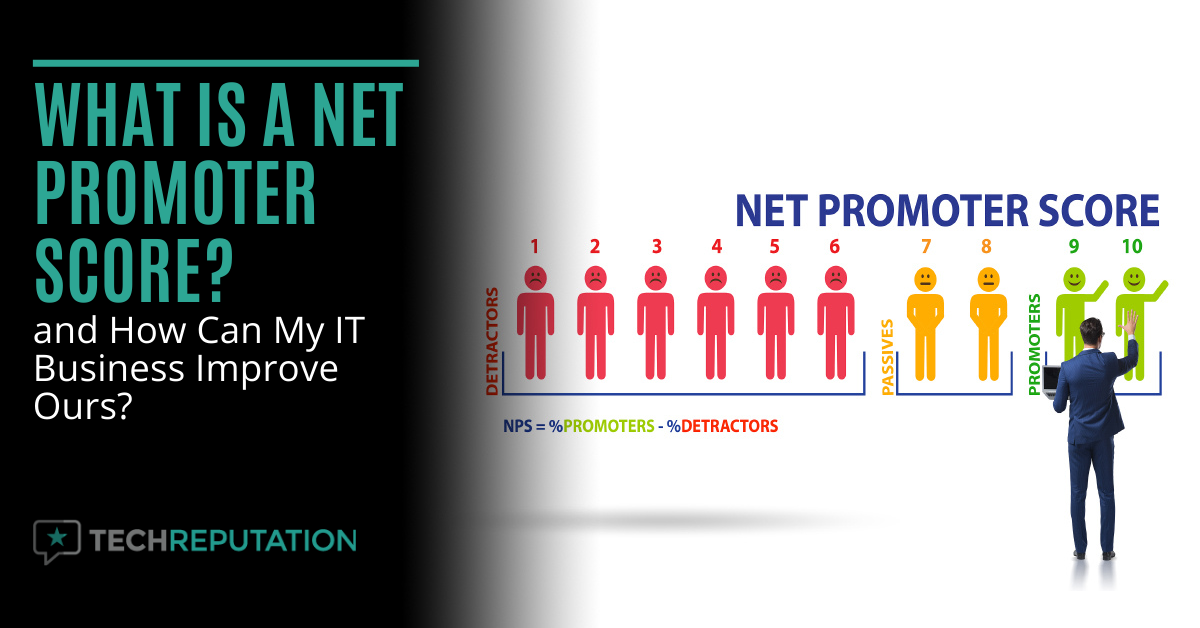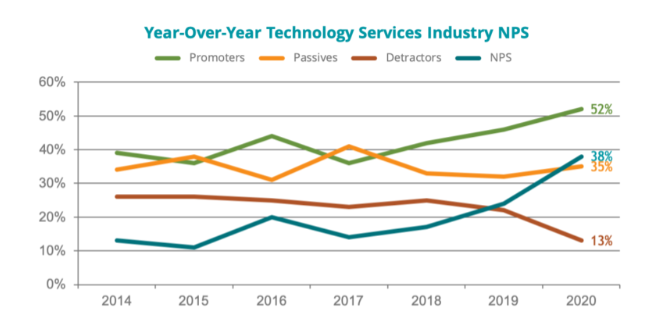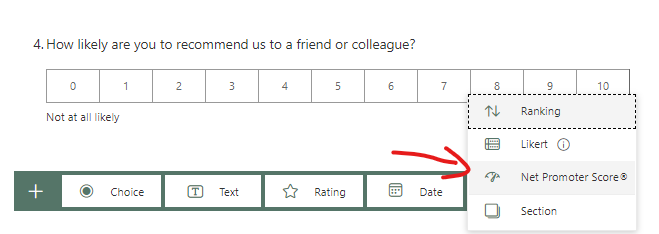What Is a Net Promoter Score? and How Can My IT Business Improve Ours?

There are many ways to gauge customer satisfaction and predict how well a business is doing, and the one that is lauded as the “gold standard” is the Net Promoter Score® (NPS®).
A good number of MSP business owners have heard the term in passing but don’t really know what it is or how they can use it as a tool to improve customer experience and business reputation.
We’ll go through the basics of what Net Promoter Score is, how to use it, and how you can improve your own NPS to retain current customers and attract new ones.
Net Promoter Score Basics
First, let’s start with where Net Promoter Score came from. NPS was developed in 1993 by business consultant Fred Reichheld. In 2003, this system was adopted by Bain & Company and Satmetrix as a way to predict customer referral and purchase behavior.
It’s been such a simple and successful tool that it’s still in wide use today by businesses around the world.
NPS asks a single question to customers: “How likely are you to recommend us to a friend or colleague?”
It sounds like an elementary query, but it’s one that provides important insights into the future growth of a company. It goes beyond just asking if a customer is happy themselves, and instead is basically asking are they happy enough to tell others they know about your products or services.
There are two important revenue related areas that Net Promoter Score can be used to predict, these are referrals and customer loyalty. Both are important when it comes to your bottom line.
Here are a few reasons that you want to pay attention to both loyalty and referrals:
- 65% of an average company’s business comes from repeat customers.
- It costs 5x as much to acquire a new customer than to retain an existing one.
- Verbal referrals have the best conversion rate (32%) of any other form of lead generation.
How Net Promoter Score is Used
The Net Promoter Score is typically used in a survey to customers, such as an Annual Customer Satisfaction Survey.
It’s generally one question that is included with a few others, such as how happy someone is with your services, what they like most about your company, what could be improved, etc.
You can find several examples of customer satisfaction surveys and a Net Promoter Score survey here at SurveyMonkey.
How NPS Scoring Works
The “magic” of Net Promoter Score is in the scoring system and how to translate that to how well your company is doing and the future potential of referral and repeat customer revenue.
When the question, “How likely are you to recommend us to a friend or colleague?” is asked, the respondent answers using a scale of 0 – 10. At the bottom is 0, not at all likely to recommend and at the top is 10, extremely likely to recommend.

The range of numbers corresponds to whether someone likes you enough to recommend you to others. While you might think a score of 8 would be pretty good, the NPS scoring system isn’t quite so generous. It keeps it “real” by including Passives, who may say they’re satisfied with your business but aren’t very enthusiastic about you, thus could leave at any time.
- Score of 0-6 = Detractors: Detractors are customers that are not happy with your business and could damage your reputation if they gave you a bad review or through negative word-of-mouth.
- Score of 7-8 = Passives: These are customers that are fine with your offerings and may have been with your business for a while. However, they’re not over-the-top happy about you, making them potentials to be poached by competitors.
- Score of 9-10 = Promoters: These are the customers that you’re doing an awesome job keeping happy. They are enthusiastic about your business and most likely are bring you more business through referrals.
To get to your overall score, you would simply take the percentage of Detractors you have and subtract those from Promoters. Passives aren’t included in the final score.
So, say that you received surveys back from 150 customers and you had:
- 5% Detractors (they indicated 0-6)
- 25% Passives (they indicated 7-8)
- 70% Promoters (they indicated 9-10)
You would take the 5% Detractors and subtract those from the 70% Promoters for a Net Promoter Score of 65% (or 65).
What Does My Net Promoter Score Mean?
So, you have a Net Promoter Score of 65… what does that mean?
It depends upon your industry. There are benchmarks used to gauge how good or bad a company’s NPS is compared to others in the same industry. For example, according to Retently, the average NPS for the insurance industry is 70, but if you’re in the financial services industry, 34 is the average.
For IT services, the average Net Promoter Score is 38. If you have a 38 that means you’re average. Lower would be doing worse than others in your industry. If you had a 65, you would be doing outstanding.

Graph is from ClearlyRated
Knowing your Net Promoter Score is like shining a light on any issues that you might not realize have been holding you back. For example, you might find that most of your customers are Passives, thus not really referring your company to others and in danger of leaving if enticed by another IT business.
Information is power, so if you know you have a bunch of “just fine” passive customers, it can be a driver for turning those Passives into Promoters by increasing your level of customer support.
Things You Can Do to Improve Your NPS
Explain Net Promoter Score to Your Team
Your first step to improving your Net Promoter Score – and by relation, your referral and repeat business – is to let your team in on NPS and what it means.
Gaining insight into why NPS is important helps them think about customer service a little differently. In terms of we don’t just want to make this customer satisfied, we want them to be so happy that they send their friends, family, and colleagues to us as well.
Cross Reference NPS With Other Survey Questions
Your NPS is more powerful when you cross reference it with other survey questions and learn from the results. For example, take a look at all your Detractors (score of 0-6 on the “would you refer us” question). Do they have any answers in common?
Did half of them say that they had to wait too long on a service call? Do they mention having trouble with your website?
NPS helps you zero in on the customers that are having problems so you can identify and fix those to improve your overall reputation.
Follow Up Proactively With Customers
If you received a NPS of 6 or 7 from a customer, follow up and ask them how things are going. Ask if there is anything you can do that would make their life easier from an IT perspective.
You don’t have to mention that you’re calling because they didn’t give you a stellar score on their survey. Just be proactive about probing more into their needs and how you can help them.
Reaching out proactively could cause some customers to score you higher the next time you survey them because they feel well taken care of.
Engage With Customers Over Social Media
People tend to let their hair down a bit more when posting on social media, so you can often gain some great insights into customer needs by engaging over platforms like Facebook and LinkedIn.
Pay attention to any inquiries you get on social media or replies to your posts. You can also just ask a question every now and then, such as, “What service do you wish we had?”
Engaging with customers on social media can also build trust and loyalty and result in customers feeling more connected and loyal.
Monitor Your Business Reviews
An important way to see if your customer service is going off the rails is to monitor reviews that customers are posting about your MSP business on sites like Google, Yelp, and others.
Companies that don’t monitor and actively manage their reviews can quickly see a good reputation start to fall because they aren’t keeping up with how customers feel about them.
Using an MSP reputation management platform can help you easily keep track of reviews posted on multiple sites, be alerted as soon as one comes in, and make it less time consuming to reply to reviews. Replying regularly to reviews can improve your NPS.
Continue to Survey and Gauge Your NPS
Net Promoter Score isn’t a “one and done” activity. It’s important to regularly ask that question, “How likely are you to recommend us to a friend or colleague?” using the 0 – 10 scale. At least do this annually on a customer satisfaction survey so you can see if your activities to improve your customer experience are improving your NPS as you anticipate.
One easy way to create a survey using Net Promoter Score is through the free application, Microsoft Forms.
They already have a template you can use for a customer satisfaction survey, and Net Promoter Score is one of the question options when building a form!

Adding the Net Promoter Score question in Microsoft Forms.
Keeping track of your Net Promoter Score is an easy way to get out in front of any potential issues that could derail your growth.
Use Net Promoter Score as Part of Your Customer Retention Strategy
As simple as it is, Net Promoter Score is a powerful way to stay on top of your customer retention and loyalty, which ties in directly to your bottom line.
Do You Know Your Net Promoter Score? Share your experience in the comments!
Leave a Reply